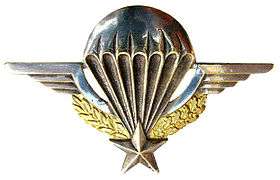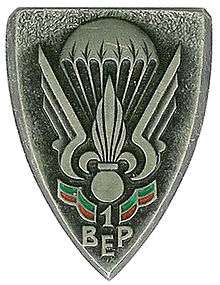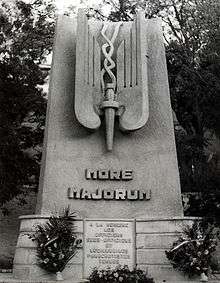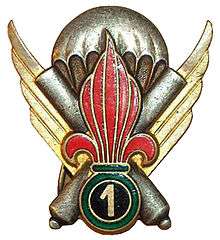2nd Foreign Parachute Regiment
The 2nd Foreign Parachute Regiment (French: 2e Régiment étranger de parachutistes, 2e REP) is the only airborne regiment of the French Foreign Legion. Since the regiment's arrival from Algeria in 1967, it has been stationed at Camp Raffalli near the town of Calvi on the island of Corsica, south of mainland France. It is one of the four infantry regiments of the 11th Parachute Brigade[5] and part of the spearhead of the French rapid reaction force.[5][6] The regiment is also equipped with Véhicule de l'Avant Blindé (VAB).
| 2nd Foreign Parachute Regiment | |
|---|---|
| 2e Régiment Etranger de Parachutistes | |
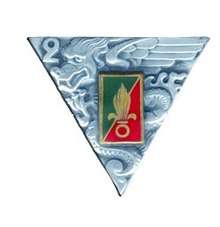 Badge of the 2nd Foreign Parachute Regiment | |
| Active | 2e BEP Bataillon étranger parachutistes 1948–1955 2e REP Régiment étranger parachutistes December 1, 1955 – present |
| Country | |
| Allegiance | |
| Branch | |
| Type | Parachute infantry regiment |
| Role | Primary Tasks:
Specialised roles:
|
| Size | c. 1,200 |
| Part of |
|
| Garrison/HQ | Calvi, Corsica France |
| Motto(s) |
|
| Colour of Beret | Green[3] |
| March | La Legion Marche[4] (The Legion Marches) |
| Anniversaries | Camerone Day (30 April), Saint-Michael Day (29 September) |
| Engagements | First Indochina War
Algerian War
Lebanese Civil War 1975–1990
Kuwait 1990–1991 Global War on Terrorism (2001–present)
|
| Commanders | |
| Current commander | Colonel De La Chappelle |
| Notable commanders | Rémy Raffalli Jacques Lefort Pierre Darmuzai Paul Arnaud de Foïard Jeannou Lacaze Bernard Goupil Jean Brette Philippe Erulin Jean Louis Roué Bernard Janvier Bruno Dary Benoît Puga Alain Bouquin Éric Bellot des Minières |
| Insignia | |
| Insignia of 2nd Foreign Parachute Regiment | 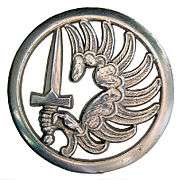 |
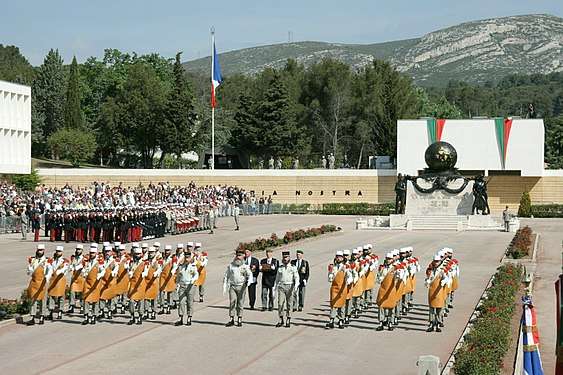
The 2e REP is composed in 2016, of ten companies out of which five combat companies are numbered from 1 to 5 and the reserve company is numbered 6.
Descended from the 2nd Foreign Parachute Battalion which served in Indochina, it fought in Algeria, and more recently in Kolwezi (Zaïre) during the Battle of Kolwezi in 1978. Having participated in all French exterior operations since 1970, the regiment has operated in Chad, Lebanon, and the former Yugoslavia since 1992, at Djibouti, Rwanda, in Central Africa and even Gabon. In 1997, the regiment was engaged in the Congo-Brazzaville during Operation Pelican (French: Opération Pélican). From 2002–2003, at the beginning of Opération Licorne, the regiment was engaged in the Ivory Coast. More recently in 2010, the regiment fought in Afghan theatre as part of the Brigade La Fayette (or Task Force La Fayette) as GTIA Surobi, code Battle Group Altor.
History
The Parachute Company of the 3rd Foreign Infantry Regiment was created on April 1, 1948.[7] The command of the company was given to a 23-year-old Lieutenant, Jacques Morin. He commanded the company from April 31, 1948, to May 31, 1949.[7] Volunteers filled in the ranks from the foreign regiments present already in Indochina.[7] Part of the 3rd Foreign Infantry Regiment, the parachute company operated under different battalions.[7] Following a series of combat action operations in the most exposed sectors of the high regions and airborne operations in the Delta, the company was dissolved on May 31, 1949.[7] At the time the company disbanded, it comprised three Legion officers, 14 Sous-officiers, and 92 corporals and legionnaires, all of whom were transferred to the 1st Foreign Parachute Battalion which had just disembarked in Indochina.[7] Jacques Morin created the parachute company insignia in 1948.
1st Foreign Parachute Battalion (1948–1955)
The 1st Foreign Parachute Battalion (1er BEP, first formation) was created on July 1, 1948, at Khamisis, in Algeria.[8] The 1er B.E.P disembarked in Indochina on November 12 and was engaged in combat operations in the Tonkin.[8] On June 1, 1949, the Para Co. 3e REI completed its count.[8] On November 17, 1950; the 1st Foreign Parachute Battalion jumped on That Khé and sacrificed itself in Coc Xa to protect the unfolding of the RC4.[8] The 1er B.E.P battalion commander was Chef de Corps du 1er B.E.P, Commandant Pierre Segrétain.[8]
The battalion was dissolved on December 31, 1950; was reconstituted on March 1, 1951 (1er B.E.P, II formation) and was seen participating excessively in combat operations at Cho Ben, on the black river and at Annam.[8] On November 21, 1953; the reconstituted 1er B.E.P was parachuted on Dien Bien Phu.[8] At Dien Bien Phu, the reconstituted (1er B.E.P, II formation) 1er B.E.P counted 575 killed and missing for the second time.[8] Amongst the fatal casualties were Lieutenants Dumont, Boisbouvier and de Stabenrath, killed in between April 1 and May 13 as well as Sergent-Chef Grimault, killed on March 30.[8] Reconstituted for the third time (1er B.E.P, III formation) on May 19, 1954, the 1er B.E.P left Indochina on February 8, 1955.[8] The 1er B.E.P totaled 5 citations at the orders of the armed forces and the fourragère of the colors of the Médaille militaire.[8] The 1st Foreign Parachute Battalion (1er B.E.P, III Formation) became the 1st Foreign Parachute Regiment (1er R.E.P) in Algeria on September 1, 1955.
The insignia of the 1st Foreign Parachute Battalion was created in 1948 by Commandant Segrétain, battalion commander Chef de Bataillon, CBA of the 1er B.E.P.[8]
3rd Foreign Parachute Battalion (1948–1955)
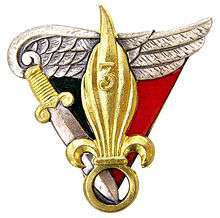
The 3rd Foreign Parachute Battalion (3e BEP) was created on April 1949 at Mascara.[9] The 7th combat company of paratrooper training of the 1st Foreign rejoined Sétif 7 months later, starting November 15, 1949, becoming officially the 3rd Foreign Parachute Battalion.[9] The mission of the 3e B.E.P was to instruct the legionnaires destined to relieve the 1st and 2e B.E.P.[9] It also participated in operations to maintain order in Tunisia from January to June 1952.[10]
On May 4, 1954, as the Battle of Dien Bien Phu was underway, the battalion made its way to Indochina.[9] On May 25, 1954, the battalion is at Haïphong.[9] On June 1, the count of the men forming the 3e B.E.P was transferred to the 2nd Foreign Parachute Battalion during the reconstitution of the later.[9] The 3rd Foreign Parachute Battalion merged with the injured of annihilated foreign battalions while in the meantime, owing to numerous volunteers, the 3e B.E.P was seen reconstituted at Sétif.[9] Back to Algeria, the three foreign paratrooper battalions (1er B.E.P, 2e B.E.P, 3e B.E.P) would be seen filling the ranks of the foreign paratrooper regiment. On September 1, 1955, the 3e B.E.P. became the 3rd Foreign Parachute Regiment (3e REP).[9] Based at Batna, the regiment became operational but then was dissolved on December 1, 1955; the men constituting the regiment were merged with the 2nd Foreign Parachute Battalion, (2e B.E.P.) to form a new corps, the 2nd Foreign Parachute Regiment (2e R.E.P.).[9]
The insignia of the 3rd Foreign Parachute Battalion was created in 1950 by Captain Pierre Darmuzai, battalion commander Chef de Bataillon, CBA of the 3e B.E.P.[9]
1st Foreign Parachute Regiment (1955–1961)

Disembarked in Algeria on February 25, 1955, the 1st Foreign Parachute Battalion (1e B.E.P.) became the 1st Foreign Parachute Regiment (1e R.E.P.) on September 1, 1955.[11] Based at Zéralda, the regiment was composed of one command and support company, one assault company and three combat companies.[11] Quite quickly, operations commenced: Nementchas, Tunisian and Moroccan frontiers, Ouarsenis and de Suez.[11] On November 6, 1956; the regiment disembarked at Port-Fouad and operated quickly along the canal.[11] The progression of the regiment was halted by the ceasefire and the regiment was quick to make way to operate around the mountains of Algeria by December 10.[11]
Following the petrol route in the Sahara, combat operations engaged the regiment non-stop in the region of Guelma.[11] The magnificent results were endured by the death of superior French regimental commander Chef de Corps Legion Lieutenant Colonel Pierre Paul Jeanpierre; the legendary Para Legionnaire leading; who fell to the enemy on May 28, 1958, along with a couple of hundred legionnaires.[11] In 1959, action around the mountains retook course in operations "Jumelles", "Cigales" and "Ariège" in the Aurès, ending in Kabylie.[12] Lory representation of paratrooper legionnaires; the reputation of the 1st Foreign Parachute Regiment (1er R.E.P) was tarnished with the unfortunate events of the Generals' Putsch.[11] The regiment was dissolved on April 30, 1961, at Thiersville.[11]
The 1st Foreign Paratrooper Regiment used the insignia of the 1st Foreign Parachute Battalion (1er B.E.P), with a new inscription "1er R.E.P".[11]


2nd Foreign Parachute Battalion – 2e BEP (1948–1955)
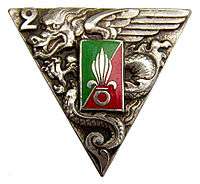
The 2nd Foreign Parachute Battalion (2e B.E.P) was created on October 1, 1948, by execution of a ministerial prescription dating to March 27, 1948.[13] The combat companies of the 2e B.E.P were constituted by the 4th Demi-Brigade of the Foreign Legion (4e D.B.L.E) in Morocco and the depot of the foreign regiments in Sidi-bel-Abbès, were assigned by the 25th Airborne Division Element (French: 25e Elément Divisionnaire Aéroporté, EDAP/25).[13] Comprising one command company and three combat companies type fusiliers-voltigeurs, the battalion made and cleared way to Oran on January 19, 1949, destined for Indochina.[13] Disembarked in Saïgon on February 9, the battalion was directed to Kép (Cambodia) by land route.[14] On November 1949, the battalion took base in Quan Thé.[15]
The first combat engagements of the 2e B.E.P have for theatre of operations, Cambodia, Cochinchine and Annam.[14] On October 1950, the 2e B.E.P was summoned to Tonkin. Reinforced by a heavy mortars company, the battalion engaged in all military operations in the Delta, in Thaï lands, Mékong and the plains of Jarres.[14] The impressive series of combat engagements were earned at the battle of Nghĩa Lộ, colonial route N°6 (RC6), Hòa Bình and the defense of the camp by an airborne operation on Langson.[14] Crowned of a magnificent epoque, the 2e B.E.P made and cleared way to Dien Bien Phu on April 9 and 10 of 1954 in the middle of the furnace.[14] Following the couter-attack of supporting point "Huguet", led by a rare determination during the night of the 22 and 23 of April; the 2e B.E.P and the 1st Foreign Parachute Battalion (1er B.E.P) merged to form a single Foreign Marching Battalion. On May 7, the Foreign Marching Battalion was dissolved and the 2e B.E.P was recreated by members of the 3rd Foreign Parachute Battalion (3e B.E.P).[14] On June 1, 1954, the 2e B.E.P left Asia on November 1, 1955.[14] The colors of the battalion were decorated with 6 citations at the orders of the armed forces and the Fourragère of the colors of the Legion of Honor.[14] The losses of the 2e B.E.P endured 1500 Legion Officers, Sous-Officiers and Legionnaires killed along with their "chef de corps", Legion Commandant Barthélémy Rémy Raffali leading and heading tradition.[14] Returned to Algeria, the 2nd Foreign Parachute Battalion (2e B.E.P) became the 2nd Foreign Parachute Regiment (2e R.E.P) on December 1, 1955.[14]
The insignia of the 2nd Foreign Parachute Battalion was created in 1949, in Cambodia. The battalion insignia represents an Eastern winged Dragon making reference to the original implementation in Asia.[16] The three point triangular shape of the insignia represents the form of an open parachute; centered by the flag colors of the Legion; and is symbol of the perfection that is expected of the men that may serve this regiment.[16] The battalion was commanded at the time by commandant Solnon (1948–1950).[14]
Foreign Parachute Battalion & Regiment – 2e BEP then 2e REP (1954–1962)
Events in Algeria (1954–1962)
On December 1, 1955, the 2nd Foreign Parachute Battalion, 2e B.E.P was enlarged to a full regiment, and was redesignated as the 2nd Foreign Parachute Regiment (French: 2e Régiment étranger de parachutistes, 2e R.E.P).[17] The regiment served throughout the Algerian War and suffered a total of 741 casualties.[18]
When the 2nd Foreign Parachute Battalion 2e BEP left the Far-East on November 1, 1955, the fanion of the battalion counted six palms and the Fourragère with colors of the Légion d'honneur. The battalion had endured the loss of 1500 Officers, Sous-Officiers and Legionnaires out of which one battalion commander. On December 1 the 2e BEP became the 2nd Foreign Parachute Regiment 2e REP. During the first combat engagement of the foreign regiment, on January 5, the regiment endured the loss of the first fatality, while the outlaws (French: Hors La Loi, HLL) lost 22 of theirs. Regrouped at Philippeville (French: Philippeville), the companies covered the appropriate sectors.
From March to June, two units operated in the Aurès (French: Aurès). April 30 was marked with hard combat engagements. The regimental colors were received on June 5. In November, the regiment changed sectors. The command post set camp at Tébessa (French: Tébessa). In operational reserve, the regiment had for mission to run surveillance of the Algerian-Tunisian Border. The year of 1956 ended with 900 rebels killed, 500 prisoners and significant war material recuperated. The foreign regiment had endured the loss of 38 men killed in combat.
On April 1957, the regiment returned to Philippeville. On May 30, the regiment left garrison and made way to El Milia (French: El Milia) in order to ensure the security of the almost island looking Collo and the region of Jijel (French: Jijel). In August, the regiment returned to Tébessa for a series of operations on the border where 35 rebels where placed out of combat at the expense of the lives of six Legionnaires. On December 18, the foreign regiment destroyed an opposing battalion size in the Hamimat Guerra. The rebels deplored 45 fatalities. In 1960, the regiment was spread in different garrisons : Chekfa, Tleta, Chahna, Siar and Philipeville at camp Pehau. During the 1st trimester, « Opération Turquoise » occupied the regiment which deplored four fatalities, eight wounded, however, the enemy left 24 outlaws (French: Hors La Loi, HLL), 2 prisoners, 5 defeated escapees, and 17 arrested suspects. One type 20 mm cannon recuperated, 1 PM, 10 war rifles and numerous munitions were destroyed. A couple of secondary operations were mounted such as « Saxophone » on January 26 and 27, "Clarinette" (3 HLL killed and one prisoner), « Basson I » on February 20 and 21, « Basson II » on March 8 and 9, (six HLL killed and 24 suspects arrested), « Zacharie » (1 leading figure died committing suicide and 2 defeated escapes) from March 15 to 17, « Victorien » (four defeated escapees), then in the 2nd trimester, « Turquoise » with secondary operations « Poisson » (two HLL killed, eight suspects arrested) on April 1 and 2, « Basson III » (three HLL killed and defeated escapees, on April 19, one Officer and two Legionnaires were killed in an ambush). After « Turquoise », followed « Opaline » in June.
In the first days of 1958, the 2e REP accelerated the rhythms of combats. On April 26 and 27, the foreign regiment placed out of combat 209 HLL (outlaws) in the region of Sbihi, recuperating a strong arsenal out of which 3 mitrailleuses. On the 30, during the celebration of Camarón, a series of locations seals were placed into effect in order to intercept a band of rebels making way towards Ahras. 84 of them were killed. In January 1959, the foreign regiment made way towards Guelma, as operational reserve for the zone East Constantine. On March 1, the foreign regiment annihilated a battalion size force at Gambetta. On June 23, another battalion size rebel force was dismantled. 29 HLL were killed and 10 were made prisoners. During the 3rd trimester, the operations "Pierres précieuses" were launched. West Constantine was racked. The casualty results were heavy: 229 HLL killed, 99 prisoners, and the foreign regiment endured the loss of 11 Legionnaires. In January 1960, the 2e REP, at the corps of the 25th Parachute Division 25e DP operated in the sector of Djidjelli. It's operation "Turquoise" again, secondary operation of operation "Pierres précieuses". On September 23, the foreign regiment returned to its rear base in Philipeville before rejoining Hammama where operation "Ariège" was commencing and which concerned the regions of Biskra and Kenchela. Before leaving the Aurès, the 2e REP inflicted another defeat on the rebels in Chelia, finishing with 53 HLL killed. On December 28, the foreign regiment made movement towards Oran then Tlemcen where the regiment arrived on December 30.
On May 1, 1961, following the dissolution of the brother regiment: the 1st Foreign Parachute Regiment 1er REP, the foreign regiment remained the only unit heir of all the para-legion units created since 1948. As much as the Cadres and Legionnaires of the foreign regiment pleasantly say : "The Foreign is Second to None" (French: "Le second de personne").
Placed at the disposition Western Oran zone in reinforcement of the Algerian-Moroccan Barrage, the foreign regiment remained until January 28, date where the later was found in the rear base. The operations, police rounds and presence rounds followed each other in the regions of Calle, Milia, Philipeville until March 18, 1962, date of the ceasefire which the foreign regiment learned of at Telergma. In less than seven years, more than 4000 rebels were placed out of combat and nearly 4000 individual arms and more than 200 collective arms were ceased.
The foreign regiment left Constantine, on August 30, 1962, after a continuous quasi presence for 6 years in the same region. On September 16, the foreign regiment regrouped at Bou-Sfer in the enclave of the Strategic Base of Mers El Kébir.[19]
2nd Foreign Paratrooper Regiment – 2e REP (1955–present)

The transition (1962–1967)
Starting 1962 and at the signature of the Évian Accords (French: accords d'Évian), the French military progressively left Algeria to be repatriated to metropolis France. For the first time in Legion history, Legion regiments would be garrisoned in mainland France.
For the 2e REP, this move would be made progressively between 1965 and 1967. From the former new garrison at Bou-Sfer, the last French Base on the Algerian territory, the Regiment would send units to start preparing the new garrison, situated in Calvi, in Corsica. This garrison was the former garrison of the 1st Parachute Choc Battalion of the 11th Parachute Choc Demi-Brigade, dissolved in 1963.
The complete move would be effective in June 1967 and the regiment joined the 11th Parachute Division.
That period, first period of peace in the history of the regiment after 14 years in existence, was accompanied with various challenges, significant for the legionnaires. The legionnaires had to face political decisions which were hard to comprehend. The dissolution of their "brother regiment", the 1st Foreign Parachute Regiment following the generals putsch left the regiment in significant disarray.
In addition, the foreign regiment was in a null phase of operations activity. The Regiment was garrisoned in camp, and stuck with no permission to move out of the designated area while being encircled by the local Algerian army, with whom the foreign regiment led a war against for 8 years. Accordingly, the training and routine affected deeply the esprit de corps of the legionnaires.
It was during this époque, under Colonel Caillaud, that the companies started to specialize in a particular task: Anti-tank combat (1st company), Mountain combat (2nd company), Amphibious combat (3rd company) and Destruction explosive activities (4th company).
This regrouping reformed the R.E.P into an elite para-commando force.[20] In June 1967 the regiment was moved to its current base at Camp Raffalli, Calvi on the island of Corsica.[20] It was assigned to the 11th Division and became part of France's rapid intervention forces.[20]
(1967–1978)
- Chad: (in 1969, Operations Pout, Manta, Sparrowhawk): Elements of the regiment were deployed to Chad in April 1969 as part of a French force to support the government against two rebel forces. Returning at the end of 1970. Individual companies were deployed again in 1978–79 to protect French lives and again in 1984.[20]
- French Territory of the Afars and the Issas: (1976 Loyada, 1992 Operation Iskoutir).
- Zaire: In May 1978, a force of gendarmes katangais entered the Katanga province of Zaire from Angola and occupied the mining town of Kolwezi. They began to loot the town and kill government soldiers and civilians (including several Belgian and French employees of a mining company). At the request of the government of Zaire, 2 REP was airlifted to Kinshasa and dropped on Kolwezi. The operation was a success and the town was quickly recaptured with minor casualties in the ranks of the paratroopers. Some 120 civilian hostages died in the occupation.
(1978–2015)
In 1994, the COMPARA (parachute company) which the REP armed in Djibouti (13e DBLE) was dissolved. Nevertheless, the 2e REP continued each year to supply a turning « captive » until the departure of the 13e DBLE on June 13, 2011.
- Lebanon: (Operation Épaulard I spearheaded by Lieutenant-colonel Bernard Janvier from August to September 1982 under command of Général de brigade Jean-Claude Coullon, in preparation for the Multinational Force in Lebanon and then U.N.I.F.I.L ) along with the 31e Brigade which included the Operational Group of the Foreign Legion.
- Kuwait: (Reconnaissance and Deep Action Commandos (French: Commandos de renseignement et d'action dans la profondeur), contingents of 1er R.P.I.Ma in Division Daguet part of Opération Daguet undertaken in Saudi Arabia under the command of Général de brigade Bernard Janvier )
- Rwanda: (1990, 1992, Operation Noroit)
- Gabon: (1990, Operation Shark)
- Somalia: (1992, Operation Oryx)
- Central: (1996, Operation Almandine)
- Congo-Brazzaville: (1997, Operation Pelican)
- Former Yugoslavia: (1993 Sarajevo, 1995 RIF 1996 and 1999 KFOR, Kosovo 2001 and 2003)
- Côte d'Ivoire: (2002, 2004, 2006, 2010 Licorne)
2008–2015
The configuration of the REP did not fundamentally evolve until 2010 and the regiment continued to be engaged in various foreign theatres, such as Afghanistan, International Security Assistance Force ISAF with Operational Mentoring and Liaison Teams in 2008 and 2012, GTIA (Altor in 2010) and SGTIA (Ba cum in 2011) as part of Brigade La Fayette (Operation Pamir). Two Legionnaires, Pole Konrad Rygiel from 2e R.E.P G.C.P, Slovakian Robert Hutnik from the regiment were killed in action.
On January 2011, a defense base in Calvi was created.[21] Colonel Plessy was the first commandant of the designated defense base, while being the regimental commander of the 2e REP.
2e REP continued to be deploy the respective units in short duration missions in Djibouti (until the departure of the 13th Demi-Brigade of Foreign Legion in 2011), to Gabon, then New Caledonia, and as of 2012, in the United Arab Emirates as a deployed Legion infantry company the 13e DBLE (alternating with metropolis legion infantry units).
In 2012, one of the units in the United Arab Emirates protected the French Military Hospital during Operation Tamour (French: Opération Tamour) in Jordan.
During the night of January 27 and January 28, 2013, a company of the 2e REP was parachuted on the city of Tombouctou, within the cadre Operation Serval (French: Opération Serval) in Mali, a first since the Operation Bonite (Kolwezi) in 1978.[22]
In 2015, a fifth combat company was formed, specialized in the actions of desert warfare.
Global War on Terror from 2015 until present
Operation Serval (French: Opération Serval) in Mali having been replaced by Operation Barkhane (French: Opération Barkhane) in the Saharan Sahel on August 2014, 3 combat sections of the regiment parachuted in the North of Niger between April 7 and April 13, 2015.
The War on Terror in France and Opération Sentinelle is witnessing the engagements of units in reinforced OPINT (interior operations).[23]
Selection
"Shaping up" for 2e R.E.P takes 12 months of physical, mental and psychological tests across all terrain and weather conditions including special operations training.
2e R.E.P is the only regiment of the 11th Parachute Brigade which trains their own paratroopers. The Legionnaires spend their parachute training in Calvi TAP within the walls of the regiment. All other French Army paratrooper units are trained at the École des troupes aéroportées (ETAP) in Pau.
Organization

The regiment is composed of around 1140 men organized into 10 companies and a reserve unit of 60 men.[5][24] The structure of the 2nd Foreign Parachute Regiment as 2018:[7][25]
- Compagnie de Commandement et de Logistique (CCL) – Command and Logistics Company[26]
- Compagnie d'Administration et de Soutien (CAS) – Administrative and Support Company[27]
- 1re CIE – 1st Company (specialises in Urban warfare[28])[29] (a command section and 4 combat sections - note that a French section is equivalent to a platoon in Anglophone armies)
- 2e CIE – 2nd Company (specialises in Mountain warfare[30]) (a command section and 4 combat sections)
- 3e CIE – 3rd Company (specialises in Amphibious warfare[31]) (a command section and 4 combat sections)
- 4e CIE – 4th Company (specialises in Woodland Warfare[32]) (a command section and 4 combat sections)
- 5e CIE – 5th Company (specialises in Desert warfare[33]) ( a command section and 4 combat sections)
- Compagnie d'Appui (CA) (then known as Compagnie d'éclairage et d'appui – CEA) – Combat Support Company
- Missile Moyenne Portée (MMP) – Portable Medium-range Missile Platoon
- Section d'Appui Mitrailleuse (SAM) – Machine Gun Support Platoon
- Section de Tireurs d'Elite (STE) – Elite Snipers Platoon
- Groupement des Commandos Parachutistes (GCP) – Parachute Commando Group
- Compagnie de Maintenance Régimentaire (CMR) (then known as 5e Compagnie de maintenance – 5e CM) – Regimental Maintenance Company (formed August 1994)[34]
- 6e Compagnie de Réserve (6e CIE) – 6th Reserve Company (founded July 2001 upon the dissolution of the 173rd Infantry Regiment of Corsica)[35]
Consisting similarly to the DINOPS, PCG, GCM of the Legion REGs, the 2e REP operates more specialized action teams, known more recently as the GCP of the Commando Parachute Group – Groupement Commando Parachutiste which is a special forces unit of the 11th Parachute Brigade of the French Army. While GCP members of other specialized regular units wear the parachutist's red beret, the 2e REP GCP members maintains the green beret of the French Foreign Legion.[36]
Traditions

Except for the Legionnaires of the 1er REG, 2e REG, 2e REP that conserve the Green Beret; the remainder of the French army metropolitan and marine paratroopers forming the 11th Parachute Brigade wear the Red Beret.
Insignias
The insignia of the Foreign Legion Paratroopers of France represents a closed "winged armed dextrochere", meaning a "right winged arm" armed with a sword pointing upwards. The Insignia makes reference to the Patron of Paratroopers. In fact, the Insignia represents "the right Arm of Saint Michael", the Archangel which according to Liturgy is the "Armed Arm of God". This Insignia is the symbol of righteous combat and fidelity to superior missions.
Regimental Colors

Bearing stitched in golden letters, the following inscriptions.[37][38]
Regimental Songs
Chant de Marche : La Légion marche featuring:[39]
La Légion marche vers le front,
En chantant nous suivons,
Héritiers de ses traditions,
Nous sommes avec elle.
(Refrain)
Nous sommes les hommes des troupes d'assaut,
Soldats de la vieille Légion,
Demain brandissant nos drapeaux,
En vainqueurs nous défilerons,
Nous n'avons pas seulement des armes,
Mais le diable marche avec nous,
Ha, ha, ha, ha, ha, ha, ha, car nos aînés de la Légion,
Se battant là-bas, nous emboîtons le pas.
Pour ce destin de chevalier,
Honneur, Fidélité,
Nous sommes fiers d'appartenir
Au 2e REP.
Decorations
The regimental colors are decorated with:
- Croix de guerre des théâtres d'opérations extérieures with:
- 6 palms obtained during the campaigns of the First Indochina War. The 6 palms obtained during the same campaign allows the regiment to wear the red fourragère.
- Fourragère with:
- Cross for Military Valour with 4 palms for the following citations:
- Intervention at Loyada ( Djibouti, frontier with Somalia) in 1976 and the Battle of Kolwezi in 1978.[16]
- Interventions in Afghanistan with the contingents of ISAF[40](2 palms).[16]
- Airborne operations on Timbuktu during Operation Serval in 2013.[16]
- Fourragère with:
- the attribution of the two citations for the same operation theatre confers the right to wear the fourragère with colors of the Croix de la Valeur militaire (as of July, 2013)[41] and the olive colors of the Médaille militaire for the ensemble of the four conferred citations.
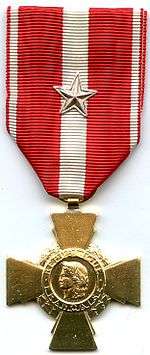
Croix de la Valeur militaire 
Croix de guerre des théâtres d'opérations extérieures 
Fourragère with color ruban of the Legion of Honor
Honours
Battle honours
Company, Battalion & Regimental Commanders

(1921–2005).
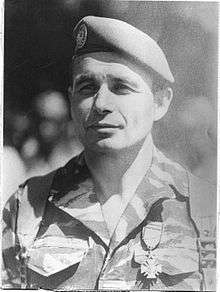
(1932–1979).

Note (* †): Legion officers killed leading their battalions and regiments
1st Foreign Parachute Battalion, 1er BEP (1948–1955) – I, II, III Formations -
|
|
3rd Foreign Parachute Battalion, 3e BEP (1948–1955) – I, II, III, IV Formations -
|
|
1st Foreign Parachute Regiment, 1er REP (1955–1961)
|
|
2nd Foreign Parachute Battalion, 2e BEP (1948–1955) – I, II, III, IV, V Formations -
|
|
2nd Foreign Parachute Regiment 1955–present
|
Commanding Officers 1955–1975[47]
|
Commanding Officers 1975–1995
|
Commanding Officers 1995–present
|
Notable Officers, Sous-Officiers and Legionnaires
|
|
|
|
|
Notes
- "2e REP: GCP Commandos training". Foreign Legion Info. 25 June 2017.
- , More Majorum, Général de division Jean Maurin Commandant la Légion étrangère (Képi-blanc Magazine).
- "French Foreign Legion Uniforms". Foreign Legion Info.
- "La Légion marche vers le front". Foreign Legion Info.
- "Les compagnies du 2e REP". Legion Etrangere. Retrieved 2011-12-31.
- The Special Forces, A History Of The World's Elite Fighting Units By Peter MacDonald, Paperback: 256 pages, Publisher: WH Smith (1987) ISBN 0-603-03895-6
- Official Website of the 2nd Foreign Parachute Regiment, History of the 2e REP, The origins...
- Official Website of the 2nd Foreign Parachute Regiment, History of the 2e REP, the 1st Foreign Parachute Battalion 1er Bataillon Etranger de Parachutistes
- Official Website of the 2nd Foreign Parachute Regiment, History of the 2e REP, the 3rd Foreign Parachute Battalion 3e Bataillon Etranger de Parachutistes"
- Official Website of the 2nd Foreign Parachute Regiment, History of the 2e REP, the 3rd Foreign Parachute Battalion 3e Bataillon Etranger de Parachutiste"
- Official Website of the 2nd Foreign Parachute Regiment, History of the 2e REP, the 1st Foreign Parachute Regiment 1er Régiment Etranger de Parachutiste
- Official Website of the 2nd Foreign Parachute Regiment, History of the 2e REP, the 1st Foreign Paratrooper Regiment 1er Régiment Etranger de Parachutiste
- Official Website of the 2nd Foreign Parachute Regiment, History of the 2e REP, 2nd Foreign Paratrooper Battalion,2e Bataillon Etranger de Parachutistes
- Official Website of the 2nd Foreign Parachute Regiment, History of the 2e REP, 2nd Foreign Parachute Battalion,2e Bataillon Etranger de Parachutistes
- Official Website of the 2nd Foreign Parachute Regiment, History of the 2e REP, 2nd Foreign Parachute Battalion,2e Bataillon Etranger de Parachutiste
- Official Website of the 2nd Foreign Parachute Regiment, Traditions, Le Drapeau du 2e REP
- Windrow, Martin (1985). French Foreign Legion Paratroops. pp. 17.
- Windrow, Martin (1985). French Foreign Legion Paratroops. pp. 22.
- Marching and Operations Journal JMO from 1954 to 196 – Articles KB same époque.
- Windrow, Martin (1985). French Foreign Legion Paratroops. pp. 27–28.
- DÉCISION No. 2164/DEF/DCSCA/SD_FBC/MODERFI relative aux trésoreries militaires des groupements de soutien de base de défense.
- Lignes de Défense, "La Légion saute sur Tombouctou" 2013/01/28 (in French)
- "Foreign Legion Operations: March 2016". French Foreign Legion Information. Retrieved 14 February 2017.
- "Les compagnies du 2e REP". 2rep.legion-etrangere.com. Retrieved 2016-11-13.
- "Current structure of the 2nd Foreign Parachute Regiment". Foreign Legion Info.
- "Compagnie de Commandement et de Logistique". Foreign Legion. Retrieved 2012-01-20.
- "Compagnie d'Administration et de Soutien". Foreign Legion. Retrieved 2012-01-20.
- "1ère Compagnie – Le combat en zone urbaine". Foreign Legion. Retrieved 2012-01-20.
- Originally specialised in Night and Anti-tank warfare.
- "2e Compagnie – Le combat en montagne". Foreign Legion. Retrieved 2012-01-20.
- "3e Compagnie – Le combat amphibie". Foreign Legion. Retrieved 2012-12-20.
- "4e Compagnie – Le combat d'usure". Foreign Legion. Retrieved 2012-01-20.
- "La 5e compagnie de combat est née". Foreign Legion. Retrieved 2015-12-27.
- "5e Compagnie – Maintenance des matériels". Foreign Legion. Retrieved 2012-01-20.
- "6e Compagnie – La réserve du régiment". Foreign Legion. Retrieved 2012-02-20.
- lys3rg0 (2 August 2012). "French Foreign Legion: GCP Le Groupement des commandos parachutistes" – via YouTube.
- "Décision n°12350/SGA/DPMA/SHD/DAT du 14 septembre 2007 relative aux inscriptions de noms de batailles sur les drapeaux et étendards des corps de troupe de l'armée de terre, du service de santé des armées et du service des essences des armées, Bulletin officiel des armées, n°27". 9 November 2007. Archived from the original on 2014-02-21. Retrieved 2015-06-06.
- Arrêté relatif à l'attribution de l'inscription AFN 1952–1962 sur les drapeaux et étendards des formations des armées et services, du 19 novembre 2004 (A) NORDEF0452926A Michèle Alliot-Marie
- Official Website of the 2nd Foreign Parachute Regiment, Traditions, Chant du 2e REP
- "La 11e BP décorée pour son engagement en Afghanistan".
- circulaire n°|13913/SDBC/DECO créant une fourragère à la couleur croix de la Valeur militaire du 28 novembre 2011
- Camerone is a Battle Honour shared by all Foreign Legion Regiments, no matter when it was formed.
- Official Website of the 2nd Foreign Parachute Regiment, Historique du 2e REP, 1er Bataillon Etranger de Parachutistes, Les Chefs de Corps
- Official Website of the 2nd Foreign Parachute Regiment, Historique du 2e REP, 3e Bataillon Etranger de Parachutistes, les Chefs de Corps
- Official Website of the 2nd Foreign Parachute Regiment, History of the 2e REP, 1er Régiment Etranger de Parachutiste, Les Chefs de Corps
- Official Website of the 2nd Foreign Parachute Regiment, Historique du 2e REP, 2e Bataillon Etranger de Parachutistes, Les Chef de Corps
- Official Website of the 2nd Foreign Parachute Regiment,Ils ont commandé le 2éme REP, Regimental Commanders
References
- Official website of the French Foreign Legion
- Porch, Douglas. The French Foreign Legion. New York: Harper Collins, 1991. ISBN 978-0-06-092308-2
- Braby, Wayne & Windrow, Martin. French Foreign Legion Paratroops. Oxford: Osprey Publishing, 1985. ISBN 978-0-85045-629-5
- Lochrie, Alex. Fighting for the French Foreign Legion. London: Pen & Sword, 2009. ISBN 978-1-84884-085-0
- The 2e Rep: French Foreign Legion Paratroopers, Yves Debay, Histoire & Collections, 2003, ISBN 2-913903-06-1, ISBN 978-2-913903-06-7
External links
- Official website – 2e Régiment étranger de parachutistes
- 2eREP veterans forum
- History and images – 2e REP History
